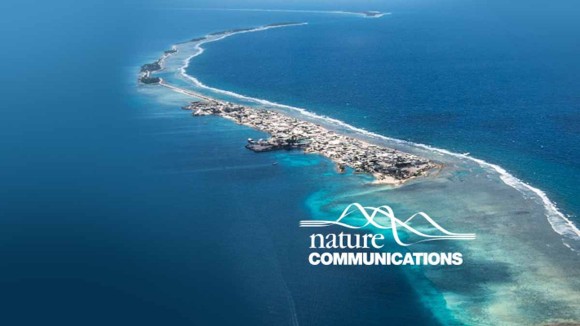Ice sheet dynamics
This section highlights research that examines the dynamics of the Antarctic and Greenland ice sheets to better understand their potential contribution to future sea-level rise. These studies examine the processes that drive ice sheet melting and instability in past, present or future climates.
Sea level fall during glaciation stabilized atmospheric CO2 by enhanced volcanic degassing
Jörg Hasenclever et al., Nat. Commun. 8 15867 (2017)
 Ice core data show a breakdown in the long-term temperature-atmospheric CO2 correlation during interglacial-glacial transitions. Here, via a novel modelling approach, the authors reveal marine volcanism, triggered by a fall in sea level, as a likely mechanism for the observed delayed decline in atmospheric CO2.
Ice core data show a breakdown in the long-term temperature-atmospheric CO2 correlation during interglacial-glacial transitions. Here, via a novel modelling approach, the authors reveal marine volcanism, triggered by a fall in sea level, as a likely mechanism for the observed delayed decline in atmospheric CO2.
Sediment transport drives tidewater glacier periodicity
Douglas Brinkerhoff et al., Nat. Commun. 8 90 (2017)
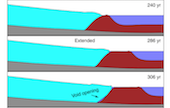 The reason some of the Earth’s tidewater glaciers are advancing despite increasing temperatures is not entirely clear. Here, using a numerical model that simulates both ice and sediment dynamics, the authors show that internal dynamics drive glacier variability independent of climate.
The reason some of the Earth’s tidewater glaciers are advancing despite increasing temperatures is not entirely clear. Here, using a numerical model that simulates both ice and sediment dynamics, the authors show that internal dynamics drive glacier variability independent of climate.
A tipping point in refreezing accelerates mass loss of Greenland’s glaciers and ice caps
Brice Nöel et al., Nat. Commun. 8 14730 (2017)
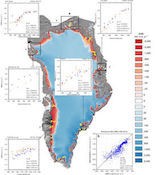 Mass loss from the Greenland ice sheet, its surrounding glaciers and ice caps, presently contributes around 43% to contemporary sea-level rise, yet the fundamental trigger remains unclear. Here, Noёl et al. analyse a novel surface mass balance product at 1 km resolution for the period 1958-2015 and identify the year 1997 as a tipping point with a rapid deterioration of the refreezing capacity of inland snow, as a threshold for causing long-term mass loss.
Mass loss from the Greenland ice sheet, its surrounding glaciers and ice caps, presently contributes around 43% to contemporary sea-level rise, yet the fundamental trigger remains unclear. Here, Noёl et al. analyse a novel surface mass balance product at 1 km resolution for the period 1958-2015 and identify the year 1997 as a tipping point with a rapid deterioration of the refreezing capacity of inland snow, as a threshold for causing long-term mass loss.
Evidence for the stability of the West Antarctic Ice Sheet divide for 1.4 million years
Andrew S. Hein et al., Nat. Commun. 7 10325 (2016)
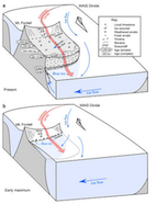 Whether the West Antarctic Ice Sheet remained intact as a regional ice sheet, or as isolated mountain glaciers during past periods of warmth remains uncertain. Here, based on geomorphological evidence from and cosmogenic dating of Ellsworth Mountains’ deposits, the authors show that at the least a regional ice sheet survived Pleistocene interglacial cycles, possibly constraining WAIS sea-level contributions during interglacials to 3.3 m above present.
Whether the West Antarctic Ice Sheet remained intact as a regional ice sheet, or as isolated mountain glaciers during past periods of warmth remains uncertain. Here, based on geomorphological evidence from and cosmogenic dating of Ellsworth Mountains’ deposits, the authors show that at the least a regional ice sheet survived Pleistocene interglacial cycles, possibly constraining WAIS sea-level contributions during interglacials to 3.3 m above present.
Rapid submarine ice melting in the grounding zones of ice shelves in West Antarctica
Ala Khazendar et al., Nat. Commun. 7 13243 (2016)
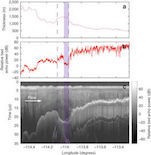 The intrusion of warm, salty Circumpolar Deep Water into submarine ice-shelf cavities is thought to control ice loss in the Amundsen Sea embayment, yet the magnitude of the effect remains poorly quantified. Here, Khazendar et al. analyse radar observations of the Dotson and Crosson ice shelves collected during NASA’s Operation IceBridge, and report intense unbalanced melting of 300-490 m of ice between 2002 and 2009.
The intrusion of warm, salty Circumpolar Deep Water into submarine ice-shelf cavities is thought to control ice loss in the Amundsen Sea embayment, yet the magnitude of the effect remains poorly quantified. Here, Khazendar et al. analyse radar observations of the Dotson and Crosson ice shelves collected during NASA’s Operation IceBridge, and report intense unbalanced melting of 300-490 m of ice between 2002 and 2009.
Clouds enhance Greenland ice sheet meltwater runoff
Kristof Van Tricht et al., Nat. Commun. 7 10266 (2016)

Clouds can exert both a warming and cooling effect on the surface of the Greenland ice sheet, yet the sign of the overall effect is dependent on the clouds’ physical and optical properties, and our understanding of which is limited by a paucity of measurements. Here, using a unique combination of satellite observations, climate model data and snow model simulations, Van Tricht et al. show clouds enhance Greenland ice sheet meltwater runoff by more than 30%.
Rapid Holocene thinning of an East Antarctic outlet glacier driven by marine ice sheet instability
Richard Jones et al., Nat. Commun. 6 8910 (2015)
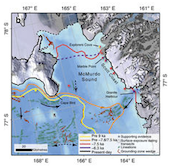 Satellite observations suggest parts of the East Antarctic Ice Sheet are experiencing dynamic thinning, which could potentially destabilize outlet glaciers and result in irreversible ice loss. However, such behaviour has not been observed in the geological record. Here, Jones et al. combine surface-exposure ages and model simulations to show rapid glacier thinning of East Antarctica’s Mackay Glacier occurred 7,000 years ago, providing geological precedent for this behaviour.
Satellite observations suggest parts of the East Antarctic Ice Sheet are experiencing dynamic thinning, which could potentially destabilize outlet glaciers and result in irreversible ice loss. However, such behaviour has not been observed in the geological record. Here, Jones et al. combine surface-exposure ages and model simulations to show rapid glacier thinning of East Antarctica’s Mackay Glacier occurred 7,000 years ago, providing geological precedent for this behaviour.
Sea-level feedback lowers projections of future Antarctic Ice-Sheet mass loss
Natalya Gomez et al., Nat. Commun. 6 8798 (2015)
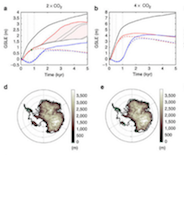 In the long-term, the retreat of marine-based ice sheets in Antarctic will contribute to global sea-level rise, yet in the short-term, post-glacial rebound and reduced gravitational pull lowers sea-level locally, stabilizing the retreat. Here, Gomez and colleagues use a coupled ice sheet – sea-level model to investigate the extent of this stabilizing effect under a wide range of future emission scenarios and reveal stabilization is greatest for low emission scenarios.
In the long-term, the retreat of marine-based ice sheets in Antarctic will contribute to global sea-level rise, yet in the short-term, post-glacial rebound and reduced gravitational pull lowers sea-level locally, stabilizing the retreat. Here, Gomez and colleagues use a coupled ice sheet – sea-level model to investigate the extent of this stabilizing effect under a wide range of future emission scenarios and reveal stabilization is greatest for low emission scenarios.
Marine ice regulates the future stability of a large Antarctic ice shelf
Bernd Kulessa et al., Nat. Commun. 5 3707 (2014)
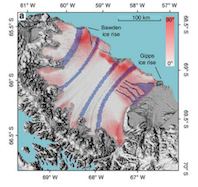 Recent dynamic and mass changes of Larsen C ice shelf on the Antarctic Peninsula have raised concerns regarding its future stability and suggestions it may follow the same fate as its collapsed cousin Larsen B. Here, Kulessa et al. use a validated ice-sheet model, constrained by satellite and in situ geophysical data to investigate the balance of stresses within the ice shelf, and reveal that marine ice-bearing suture zones are presently stabilizing the ice shelf.
Recent dynamic and mass changes of Larsen C ice shelf on the Antarctic Peninsula have raised concerns regarding its future stability and suggestions it may follow the same fate as its collapsed cousin Larsen B. Here, Kulessa et al. use a validated ice-sheet model, constrained by satellite and in situ geophysical data to investigate the balance of stresses within the ice shelf, and reveal that marine ice-bearing suture zones are presently stabilizing the ice shelf.
Antarctic contribution to meltwater pulse 1A from reduced Southern Ocean overturning
Nicholas R. Golledge et al., Nat. Commun. 5 5107 (2014)
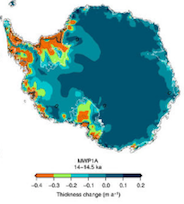 Understanding the extent to which the melting of Antarctic ice sheets contributed to rising sea-levels at the end of the last ice age will provide an important context for future sea-level variability. Here, Golledge et al. present a suite of data-constrained ice-sheet modelling experiments and conclude that the retreating ice sheets of Antarctica may have contributed as much as 0.7 m per century to meltwater pulse 1A, a rapid rise in post-glacial sea level.
Understanding the extent to which the melting of Antarctic ice sheets contributed to rising sea-levels at the end of the last ice age will provide an important context for future sea-level variability. Here, Golledge et al. present a suite of data-constrained ice-sheet modelling experiments and conclude that the retreating ice sheets of Antarctica may have contributed as much as 0.7 m per century to meltwater pulse 1A, a rapid rise in post-glacial sea level.

